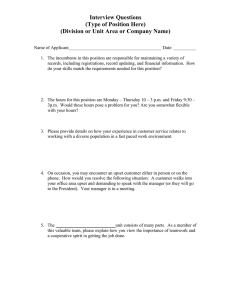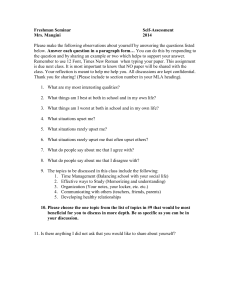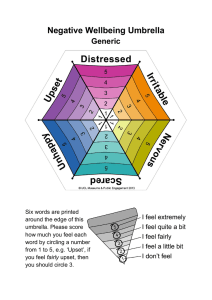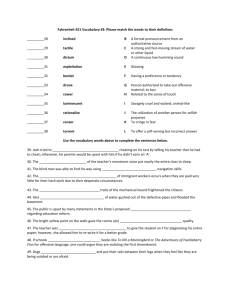Recommended Good Practice Fire Protection
advertisement
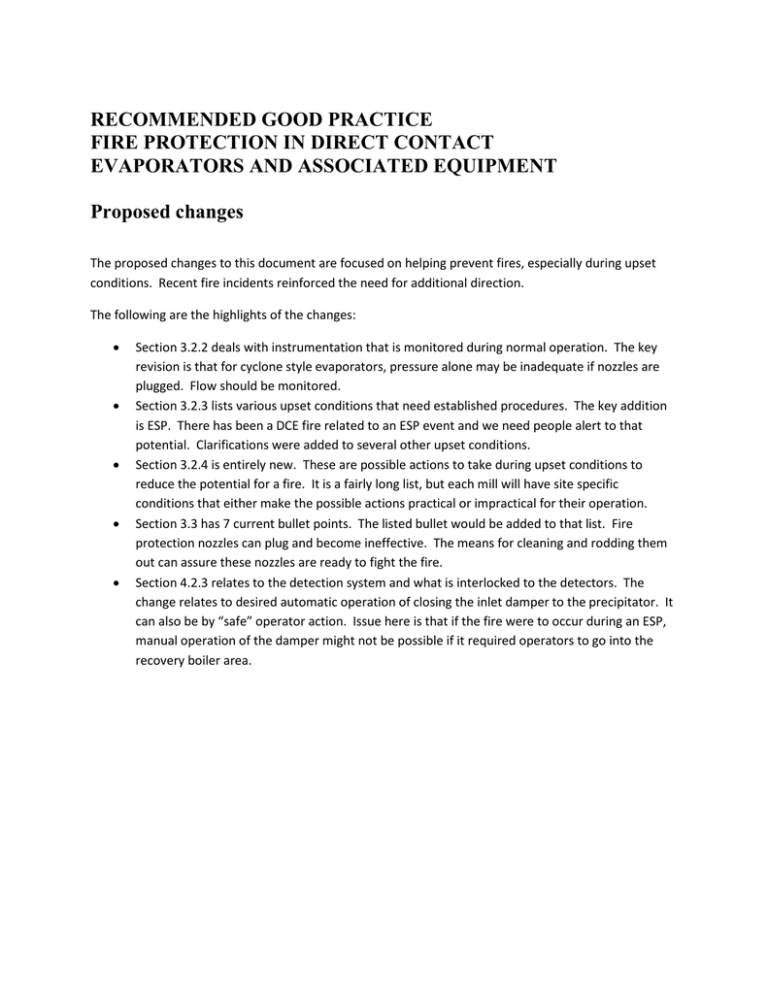
RECOMMENDED GOOD PRACTICE FIRE PROTECTION IN DIRECT CONTACT EVAPORATORS AND ASSOCIATED EQUIPMENT Proposed changes The proposed changes to this document are focused on helping prevent fires, especially during upset conditions. Recent fire incidents reinforced the need for additional direction. The following are the highlights of the changes: • • • • • Section 3.2.2 deals with instrumentation that is monitored during normal operation. The key revision is that for cyclone style evaporators, pressure alone may be inadequate if nozzles are plugged. Flow should be monitored. Section 3.2.3 lists various upset conditions that need established procedures. The key addition is ESP. There has been a DCE fire related to an ESP event and we need people alert to that potential. Clarifications were added to several other upset conditions. Section 3.2.4 is entirely new. These are possible actions to take during upset conditions to reduce the potential for a fire. It is a fairly long list, but each mill will have site specific conditions that either make the possible actions practical or impractical for their operation. Section 3.3 has 7 current bullet points. The listed bullet would be added to that list. Fire protection nozzles can plug and become ineffective. The means for cleaning and rodding them out can assure these nozzles are ready to fight the fire. Section 4.2.3 relates to the detection system and what is interlocked to the detectors. The change relates to desired automatic operation of closing the inlet damper to the precipitator. It can also be by “safe” operator action. Issue here is that if the fire were to occur during an ESP, manual operation of the damper might not be possible if it required operators to go into the recovery boiler area. Fire Protection for Direct Contact Evaporators Document Revisions 3.2.2 Normal Operations Safe operating practices should include the monitoring of instrumentation that would indicate possible upset conditions that could lead to a DCE system fire. Instrumentation in the control room should be adequate to monitor: • Cascade or Cyclone level • Cascade wheel movement • Cascade wheel drive amperage • Temperature of flue gas within at the outlet of the evaporator • Pressure drop of flue gas across the evaporator • Damper position • Wall washer pressure/flow (for cyclones flow is more important as pressure might be maintained with plugged nozzles and no flow) • Agitator operation 3.2.3 Upset Conditions Safe operating practices should include procedures to follow in the event of upset or abnormal conditions. These should include but not be limited to the following: • Cascade wheel stoppage or slow down • Boiler trips • ESP • High Cascade Drive Amp Readings (suggestion: alarming at 30% above norm, tripping at 60% above norm) (tripping the cascade is not recommended as that can create a greater fire potential) • Coupling failure • Loss of Black Liquor Flow or low flow • Mechanical damage to the system • Power Outages • Start ups and Shutdowns • Dumping vats while firing auxiliary fuel • Agitator/Flow Box Scraper failure • Strainer pluggage • High and High/High Temperature in the DCE 3.2.4 Additional Considerations for responding to Upset Conditions (new section) Actions taken at the time of an upset condition can reduce the chances for a fire to occur. Most fires are delayed and with an ongoing upset, there may be other issues being dealt with that can delay fire discovery. The following should be considered, but each mill needs to be sure these make sense for their operation: • Automatic introduction of dilution water during an ESP event. • Maintain solids in operational range and adjust dilution as needed. • Monitor cascade amps during upset conditions to ensure adequate dilution. • Keep the cyclone recirculating and the cascade rotating during any upset. • • • • Monitor conditions for potential fire development. Can fire control functions be accomplished in the safety of the Control Room? This would include both fire system activation (steam and water) as well as damper closures. This might be especially important if the upset is an ESP. Monitor not just cyclone water wall wash pressure, but also the flow. Activation of steam smothering during loss of cascade rotation. If bypass ducting is provided around the DCE, consider opening it in upset conditions. Add an additional bullet under section 3.3 (7 existing bullets remain and noted one below is added to the list) 3.3 Physical Installation and Design • Provide a means to inspect and clean the fire protection nozzles (i.e. nozzle piping arrangement should allow for rodding out) 4.2.3 Detection The following items should be considered when designing a detection system capable of supervising and initiating a fire suppression system in the Direct Contact Evaporator: • Temperature detectors should be provided at the outlet of the evaporator and the inlet and outlet of the electrostatic precipitator. • Additional detectors may be needed for any multiple evaporators or precipitators. • Additional detectors may also be warranted within ductwork, especially over areas where accumulations of combustibles might be expected. • The detectors should activate a High alarm at the recovery control room at a temperature of 100°F (55°C) above normal and a High High Alarm should activate at 200º F (110°C) above normal operating temperature. • The High High Alarm point should be interlocked to initiate a Master Fuel Trip and operate the fire suppression system. The ID fans should also trip, the inlet damper to the precipitator should close automatically or be closed manually or safely by operator action during upset conditions including ESP, and the FD fan inlet louvers should close automatically. • The boiler should be prevented from restarting until the temperatures within the Direct Contact Evaporator are normal.
